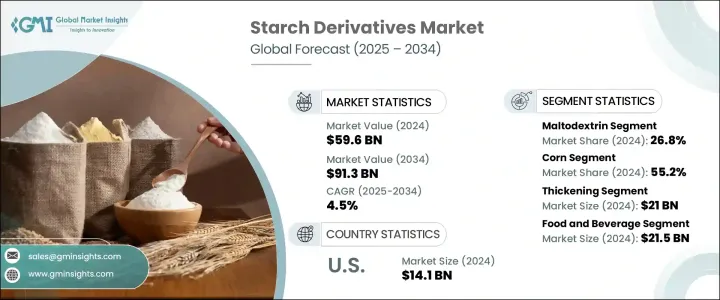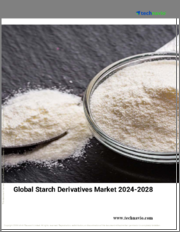
|
시장보고서
상품코드
1766254
전분 유도체 시장 기회, 성장 촉진요인, 산업 동향 분석 및 예측(2025-2034년)Starch Derivatives Market Opportunity, Growth Drivers, Industry Trend Analysis, and Forecast 2025 - 2034 |
||||||
세계의 전분 유도체 시장은 2024년에는 596억 달러로 평가되었고, 2034년에는 913억 달러에 이를 것으로 추정되며, CAGR 4.5%로 성장할 전망입니다. 소비자들이 천연, 식물성, 클린 라벨 성분을 선호하는 경향이 증가하면서 이러한 성장이 촉진되고 있습니다. 건강을 중시하는 소비자들이 합성 첨가물과 유전자 변형 성분을 피하는 경향이 증가함에 따라 제조업체들은 감자, 밀, 카사바, 옥수수 등 자연 원료에 집중하고 있습니다. 그 결과, 포도당 시럽, 변성 전분, 말토덱스트린과 같은 전분 기반 제품에 대한 수요가 계속 증가하고 있습니다. 이러한 성분은 유화, 안정화, 감미, 증점 등 다양한 기능을 제공하기 때문에 제빵, 제과, 유제품 등 식품 및 음료 응용 분야에 필수적인 성분입니다.

식품 분야를 넘어, 전분 유도체는 활성 화합물의 용해성과 제어 방출을 향상시키는 역할로 인해 의약품 분야에서도 인기를 얻고 있습니다. 이러한 산업들이 지속 가능한 솔루션을 추구함에 따라 개인 위생, 생분해성 포장, 섬유 및 제지 제조 분야에서 전분 유도체의 사용이 확대되면서 성장이 더욱 가속화되고 있습니다. 원자재 가격의 변동과 다른 천연 성분과의 경쟁 심화가 도전 과제로 남아 있지만, 친환경적이고 기능적인 대체재에 대한 수요가 증가함에 따라 전분 유도체 시장은 지속적인 성장을 이어갈 것으로 예상됩니다.
| 시장 범위 | |
|---|---|
| 시작 연도 | 2024년 |
| 예측 연도 | 2025-2034년 |
| 시작 금액 | 596억 달러 |
| 예측 금액 | 913억 달러 |
| CAGR | 4.5% |
2024년에 말토덱스트린 부문은 26.8%의 점유율을 차지했으며, 2034년까지 연평균 4.2%의 성장률을 보일 것으로 예상됩니다. 말토덱스트린은 다목적성, 중성적인 맛, 소화가 잘 되는 특성, 우수한 결합 특성으로 인해 유아 영양, 가공 스낵, 의약품에 적합하기 때문에 인기가 높습니다. 글루코스 시럽은 제과 및 사탕 제품에서 단맛과 텍스처 개선제로서의 기능으로 중요한 역할을 합니다. 또한, 가수분해물은 식이 및 임상 영양 분야에서 높은 영양 가치로 인해 채택이 증가하고 있습니다. 변성 전분은 소스, 드레싱, 즉석 식품 등에서 두께 조절 및 안정화 특성이 필수적이기 때문에 여전히 필수적입니다.
옥수수 부문은 2024년에 55.2%의 점유율을 차지했으며, 2034년까지 연평균 4.6%의 성장률을 보일 것으로 예상됩니다. 풍부한 양, 높은 전분 함량, 비용 효율성으로 인해 전분 유도체 생산에 가장 선호되는 원료로, 식품, 제약 및 산업 분야 전반에 걸쳐 다양한 용도로 사용되고 있습니다. 감자 전분은 강력한 겔화 능력으로 인해 특수 식품 및 접착제 분야에서도 주목을 받고 있습니다. 밀 전분은 빵류 제품의 텍스처 개선과 수분 유지에 가치를 인정받고 있습니다.
미국 전분 유도체 시장은 2024년 141억 달러를 기록했으며, 2034년까지 연평균 성장률(CAGR) 3.7%로 성장할 것으로 예상됩니다. 이 나라는 강력한 농업 기반, 특히 옥수수 생산에서 우위를 점하고 있어 가격 경쟁력과 공급 안정성을 확보하고 있습니다. 말토덱스트린 및 포도당 시럽과 같은 전분 유도체가 포장 식품에 널리 사용되기 때문에 국내 식품 가공 부문이 수요의 대부분을 촉진하고 있습니다. 또한, 증점제 및 결합제와 같은 제약 제형 및 개인 위생 용품에 대한 응용이 수요 증가에 기여하고 있습니다. 식품 안전을 촉진하는 정부 규제와 생산 기술에 대한 지속적인 투자는 미국이 지역 시장에서 지배력을 더욱 강화하는 요인이 되고 있습니다.
전 세계 cvn 유도체 산업의 주요 업체로는 Cargill, Inc., BENEO GmbH, AGRANA Beteiligungs-AG, Avebe U.A. 및 Archer Daniels Midland Company 등이 있습니다. 전분 유도체 산업의 선도 기업들은 시장 입지를 공고히 하기 위해 다양한 전략적 접근 방식을 취하고 있습니다. 여기에는 증가하는 수요를 충족하기 위한 생산 능력 확대와 소비자 트렌드에 부합하는 신제품 제형을 개발하기 위한 R&D 투자 등이 포함됩니다. 지속 가능성은 주요 초점 사항으로, 기업들은 책임감 있게 원자재를 조달하고 가공의 발자국을 줄이기 위해 노력하고 있습니다. 전략적 협력 및 인수를 통해 이러한 기업들은 특히 신흥 지역에서 새로운 시장과 기술에 접근할 수 있게 되었습니다. 또한, 식품, 제약 및 개인 위생 용품에 천연 성분을 찾는 건강에 민감한 소비자의 증가에 부응하기 위해 클린 라벨 및 비유전자변형(non-GMO) 제품 개발에 중점을 두고 있습니다.
목차
제1장 조사 방법
- 시장의 범위와 정의
- 조사 디자인
- 조사 접근
- 데이터 수집 방법
- 데이터 마이닝 소스
- 세계
- 지역/국가
- 기본 추정과 계산
- 기준연도 계산
- 시장 예측의 주요 동향
- 1차 조사와 검증
- 1차 정보
- 예측 모델
- 조사의 전제와 한계
제2장 주요 요약
제3장 산업 고찰
- 생태계 분석
- 공급자의 상황
- 이익률
- 각 단계에서의 부가가치
- 밸류체인에 영향을 주는 요인
- 혁신
- 산업에 미치는 영향요인
- 성장 촉진요인
- 산업의 잠재적 리스크 및 과제
- 시장 기회
- 성장 가능성 분석
- 규제 상황
- 북미
- 유럽
- 아시아태평양
- 라틴아메리카
- 중동 및 아프리카
- Porter's Five Forces 분석
- PESTEL 분석
- 가격 동향
- 지역별
- 제품별
- 장래 시장 동향
- 기술과 혁신의 상황
- 현재의 기술 동향
- 신흥기술
- 특허 상황
- 무역 통계(HS코드)
(참고 : 무역 통계는 주요 국가에서만 제공됩니다)
- 주요 수입국
- 주요 수출국
- 지속가능성과 환경 측면
- 지속 가능한 사례
- 폐기물 삭감 전략
- 생산에 있어서의 에너지 효율
- 친환경 활동
제4장 경쟁 구도
- 소개
- 기업의 시장 점유율 분석
- 지역별
- 북미
- 유럽
- 아시아태평양
- 라틴아메리카 항공
- 중동 및 아프리카
- 지역별
- 기업 매트릭스 분석
- 주요 시장 기업의 경쟁 분석
- 경쟁 포지셔닝 매트릭스
- 합병과 인수
- 파트너십 및 협업
- 신제품 발매
- 확대 계획
제5장 시장 추정 및 예측, 유형별(2021-2034년)
- 주요 경향
- 말토덱스트린
- 시클로덱스트린
- 포도당 시럽
- 가수분해물
- 가공 전분
- 양이온 전분
- 히드록시에틸 전분
- 아세틸화 전분
- 프레젤라틴화 전분
- 기타
- 액체 전분
- 기타
제6장 시장 추정 및 예측, 원료별(2021-2034년)
- 주요 경향
- 옥수수
- 감자
- 밀
- 카사바
- 쌀
- 기타
제7장 시장 추정 및 예측, 기능별(2021-2034년)
- 주요 경향
- 증점
- 안정화
- 바인딩
- 유화
- 겔화
- 보습
- 기타
제8장 시장 추정 및 예측, 용도별(2021-2034년)
- 주요 경향
- 음식
- 베이커리 및 제과
- 유제품
- 가공식품
- 음료
- 수프, 소스, 드레싱
- 기타
- 사료
- 돼지 사료
- 반추동물 사료
- 가금 사료
- 기타
- 종이
- 파형 성형
- 제지
- 기타
- 의약품
- 정제 결합
- 코팅
- 기타
- 화장품 및 퍼스널케어
- 섬유
- 산업용도
- 접착제
- 바이오플라스틱
- 기타
- 기타
제9장 시장 추정 및 예측, 지역별(2021-2034년)
- 주요 동향
- 북미
- 미국
- 캐나다
- 유럽
- 독일
- 영국
- 프랑스
- 이탈리아
- 스페인
- 기타 유럽
- 아시아태평양
- 중국
- 인도
- 일본
- 호주
- 한국
- 기타 아시아태평양
- 라틴아메리카
- 브라질
- 멕시코
- 아르헨티나
- 기타 라틴아메리카
- 중동 및 아프리카
- 사우디아라비아
- 남아프리카
- 아랍에미리트(UAE)
- 기타 중동 및 아프리카
제10장 기업 프로파일
- AGRANA Beteiligungs-AG
- Archer Daniels Midland Company
- Avebe UA
- BENEO GmbH
- Cargill, Inc.
- Emsland Group
- Fooding Group Limited
- Global Bio-chem Technology Group Company Limited
- Grain Processing Corporation
- Gulshan Polyols Ltd.
- Ingredion Incorporated
- Manildra Group
- Penford Corporation
- Qingdao CBH Co., Ltd.
- Roquette Freres
- Samyang Corporation
- Sanstar Bio-Polymers Ltd.
- Tate & Lyle PLC
- Tereos Starch & Sweeteners
- Zhucheng Xingmao Corn Developing Co., Ltd.
The Global Starch Derivatives Market was valued at USD 59.6 billion in 2024 and is estimated to grow at a CAGR of 4.5% to reach USD 91.3 billion by 2034. The rising consumer shift toward natural, plant-based, and clean-label ingredients is driving this growth. Health-conscious individuals are increasingly avoiding synthetic additives and genetically modified components, encouraging manufacturers to focus on natural sources like potato, arrowroot, cassava, and corn. As a result, the demand for starch-based products such as glucose syrup, modified starch, and maltodextrin continues to surge. These ingredients offer multifunctional benefits such as emulsifying, stabilizing, sweetening, and thickening, making them integral to food and beverage applications, especially in baking, confectionery, and dairy products.

Beyond the food sector, starch derivatives are gaining popularity in pharmaceutical applications due to their role in enhancing solubility and controlled release of active compounds. Growth is further fueled by their expanding use in personal care, biodegradable packaging, textiles, and paper manufacturing, as these industries pursue sustainable solutions. Although fluctuating raw material costs and rising competition from other natural components present challenges, the growing demand for eco-friendly and functional alternatives is expected to support the continuous expansion of the starch derivatives market.
| Market Scope | |
|---|---|
| Start Year | 2024 |
| Forecast Year | 2025-2034 |
| Start Value | $59.6 Billion |
| Forecast Value | $91.3 Billion |
| CAGR | 4.5% |
In 2024, the maltodextrin segment held a 26.8% share, and it is projected to grow at a CAGR of 4.2% through 2034. Its popularity is credited to its versatility, neutral flavor, digestibility, and superior binding characteristics, making it suitable for infant nutrition, processed snacks, and pharmaceuticals. Glucose syrup also plays a significant role due to its function as a sweetening and texture-enhancing agent in bakery and candy items. Additionally, hydrolysates are witnessing rising adoption thanks to their high nutritional content and value in dietary and clinical nutrition. Modified starch remains essential in sauces, dressings, and ready-to-eat products where thickening and stabilizing properties are critical.
The corn segment held a 55.2% share in 2024 and is forecasted to grow at a CAGR of 4.6% by 2034. Its abundance, high starch content, and cost efficiency make it the most preferred source for producing starch derivatives, supporting applications across food, pharmaceuticals, and industrial sectors. Potato starch is also gaining attention in specialized food items and adhesives due to its strong gelling capacity. Wheat starch is valued in baked goods to enhance texture and moisture retention.
U.S. Starch Derivatives Market generated USD 14.1 billion in 2024 and is expected to grow at a CAGR of 3.7% by 2034. The country benefits from a strong agricultural base, particularly in corn production, which ensures both affordability and supply reliability. The domestic food processing sector drives much of the demand, as starch derivatives like maltodextrin and glucose syrup are widely used in packaged foods. Additionally, applications in pharmaceutical formulations and personal care, such as thickeners and binders, add to the growing demand. Government regulations promoting food safety and ongoing investments in production technologies further reinforce the United States' dominance in the regional market.
Key players in the Global Starch Derivatives Industry include Cargill, Inc., BENEO GmbH, AGRANA Beteiligungs-AG, Avebe U.A., and Archer Daniels Midland Company. To solidify their market presence, leading companies in the starch derivatives industry are employing a variety of strategic approaches. These include expanding production capacity to meet rising demand and investing in R&D to innovate new product formulations aligned with consumer trends. Sustainability is a major focus, prompting companies to source raw materials responsibly and reduce processing footprints. Strategic collaborations and acquisitions allow these firms to access new markets and technologies, particularly in emerging regions. Furthermore, emphasis is placed on developing clean-label and non-GMO variants to cater to the growing segment of health-conscious consumers seeking natural ingredients across food, pharmaceutical, and personal care applications.
Table of Contents
Chapter 1 Methodology
- 1.1 Market scope and definition
- 1.2 Research design
- 1.2.1 Research approach
- 1.2.2 Data collection methods
- 1.3 Data mining sources
- 1.3.1 Global
- 1.3.2 Regional/country
- 1.4 Base estimates and calculations
- 1.4.1 Base year calculation
- 1.4.2 Key trends for market estimation
- 1.5 Primary research and validation
- 1.5.1 Primary sources
- 1.6 Forecast model
- 1.7 Research assumptions and limitations
Chapter 2 Executive Summary
- 2.1 Industry 3600 synopsis
- 2.2 Key market trends
- 2.2.1 Regional
- 2.2.2 Type
- 2.2.3 Raw material
- 2.2.4 Function
- 2.2.5 Application
- 2.3 TAM Analysis, 2025-2034
- 2.4 CXO perspectives: Strategic imperatives
- 2.4.1 Executive decision points
- 2.4.2 Critical success factors
- 2.5 Future outlook and strategic recommendations
Chapter 3 Industry Insights
- 3.1 Industry ecosystem analysis
- 3.1.1 Supplier landscape
- 3.1.2 Profit margin
- 3.1.3 Value addition at each stage
- 3.1.4 Factor affecting the value chain
- 3.1.5 Disruptions
- 3.2 Industry impact forces
- 3.2.1 Growth drivers
- 3.2.2 Industry pitfalls and challenges
- 3.2.3 Market opportunities
- 3.3 Growth potential analysis
- 3.4 Regulatory landscape
- 3.4.1 North America
- 3.4.2 Europe
- 3.4.3 Asia Pacific
- 3.4.4 Latin America
- 3.4.5 Middle East & Africa
- 3.5 Porter's analysis
- 3.6 PESTEL analysis
- 3.6.1 Technology and innovation landscape
- 3.6.2 Current technological trends
- 3.6.3 Emerging technologies
- 3.7 Price trends
- 3.7.1 By region
- 3.7.2 By product
- 3.8 Future market trends
- 3.9 Technology and Innovation landscape
- 3.9.1 Current technological trends
- 3.9.2 Emerging technologies
- 3.10 Patent landscape
- 3.11 Trade statistics (HS code)
( Note: the trade statistics will be provided for key countries only
- 3.11.1 Major importing countries
- 3.11.2 Major exporting countries
- 3.12 Sustainability and environmental aspects
- 3.12.1 Sustainable practices
- 3.12.2 Waste reduction strategies
- 3.12.3 Energy efficiency in production
- 3.12.4 Eco-friendly initiatives
Chapter 4 Competitive Landscape, 2024
- 4.1 Introduction
- 4.2 Company market share analysis
- 4.2.1 By region
- 4.2.1.1 North America
- 4.2.1.2 Europe
- 4.2.1.3 Asia Pacific
- 4.2.1.4 LATAM
- 4.2.1.5 MEA
- 4.2.1 By region
- 4.3 Company matrix analysis
- 4.4 Competitive analysis of major market players
- 4.5 Competitive positioning matrix
- 4.6 Key developments
- 4.6.1 Mergers & acquisitions
- 4.6.2 Partnerships & collaborations
- 4.6.3 New product launches
- 4.6.4 Expansion plans
Chapter 5 Market Estimates & Forecast, By Type, 2021-2034 (USD Million) (Kilo Tons)
- 5.1 Key trend
- 5.2 Maltodextrin
- 5.3 Cyclodextrin
- 5.4 Glucose syrup
- 5.5 Hydrolysates
- 5.6 Modified starch
- 5.6.1 Cationic starch
- 5.6.2 Hydroxyethyl starch
- 5.6.3 Acetylated starch
- 5.6.4 Pre gelatinized starch
- 5.6.5 Others
- 5.7 Liquid starch
- 5.8 Others
Chapter 6 Market Estimates & Forecast, By Raw Material, 2021-2034 (USD Million) (Kilo Tons)
- 6.1 Key trend
- 6.2 Corn
- 6.3 Potato
- 6.4 Wheat
- 6.5 Cassava
- 6.6 Rice
- 6.7 Others
Chapter 7 Market Estimates & Forecast, By Function, 2021-2034 (USD Million) (Kilo Tons)
- 7.1 Key trend
- 7.2 Thickening
- 7.3 Stabilizing
- 7.4 Binding
- 7.5 Emulsifying
- 7.6 Gelling
- 7.7 Moisture retention
- 7.8 Others
Chapter 8 Market Estimates & Forecast, By Application, 2021-2034 (USD Million) (Kilo Tons)
- 8.1 Key trend
- 8.2 Food and beverage
- 8.2.1 Bakery and confectionery
- 8.2.2 Dairy products
- 8.2.3 Processed foods
- 8.2.4 Beverages
- 8.2.5 Soups sauces and dressings
- 8.2.6 Others
- 8.3 Feed
- 8.3.1 Swine feed
- 8.3.2 Ruminant feed
- 8.3.3 Poultry feed
- 8.3.4 Others
- 8.4 Paper
- 8.4.1 Corrugating
- 8.4.2 Paper making
- 8.4.3 Others
- 8.5 Pharmaceuticals
- 8.5.1 Tablet binding
- 8.5.2 Coating
- 8.5.3 Others
- 8.6 Cosmetics and personal care
- 8.7 Textiles
- 8.8 Industrial applications
- 8.8.1 Adhesives
- 8.8.2 Bioplastics
- 8.8.3 Others
- 8.9 Others
Chapter 9 Market Estimates & Forecast, By Region, 2021-2034 (USD Million) (Kilo Tons)
- 9.1 Key trends
- 9.2 North America
- 9.2.1 U.S.
- 9.2.2 Canada
- 9.3 Europe
- 9.3.1 Germany
- 9.3.2 UK
- 9.3.3 France
- 9.3.4 Italy
- 9.3.5 Spain
- 9.3.6 Rest of Europe
- 9.4 Asia Pacific
- 9.4.1 China
- 9.4.2 India
- 9.4.3 Japan
- 9.4.4 Australia
- 9.4.5 South Korea
- 9.4.6 Rest of Asia Pacific
- 9.5 Latin America
- 9.5.1 Brazil
- 9.5.2 Mexico
- 9.5.3 Argentina
- 9.5.4 Rest of Latin America
- 9.6 Middle East & Africa
- 9.6.1 Saudi Arabia
- 9.6.2 South Africa
- 9.6.3 UAE
- 9.6.4 Rest of Middle East & Africa
Chapter 10 Company Profiles
- 10.1 AGRANA Beteiligungs-AG
- 10.2 Archer Daniels Midland Company
- 10.3 Avebe U.A.
- 10.4 BENEO GmbH
- 10.5 Cargill, Inc.
- 10.6 Emsland Group
- 10.7 Fooding Group Limited
- 10.8 Global Bio-chem Technology Group Company Limited
- 10.9 Grain Processing Corporation
- 10.10 Gulshan Polyols Ltd.
- 10.11 Ingredion Incorporated
- 10.12 Manildra Group
- 10.13 Penford Corporation
- 10.14 Qingdao CBH Co., Ltd.
- 10.15 Roquette Freres
- 10.16 Samyang Corporation
- 10.17 Sanstar Bio-Polymers Ltd.
- 10.18 Tate & Lyle PLC
- 10.19 Tereos Starch & Sweeteners
- 10.20 Zhucheng Xingmao Corn Developing Co., Ltd.



















